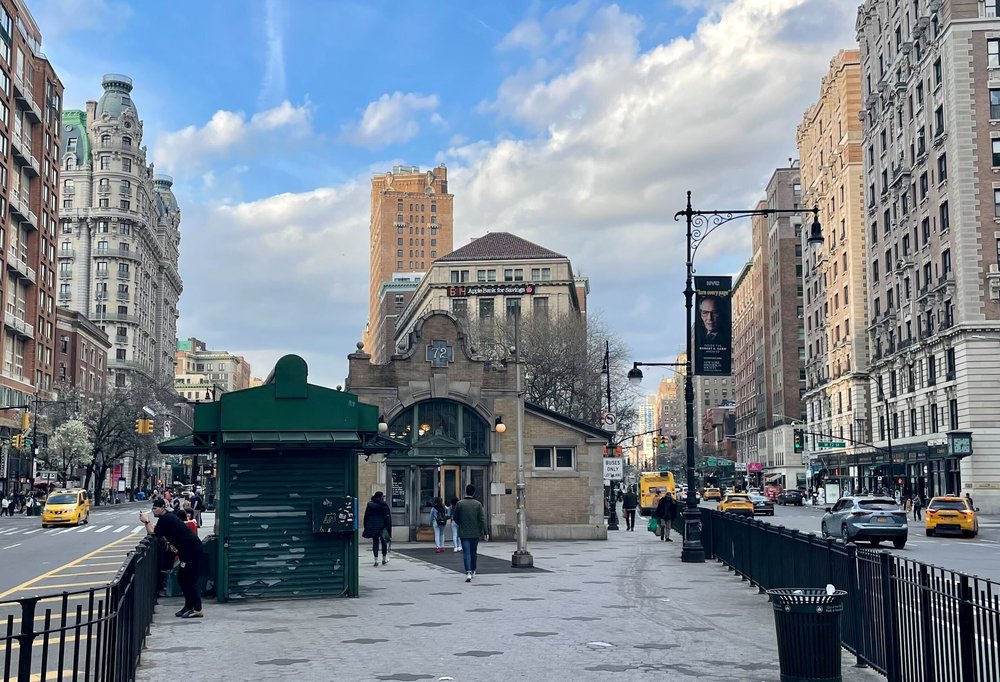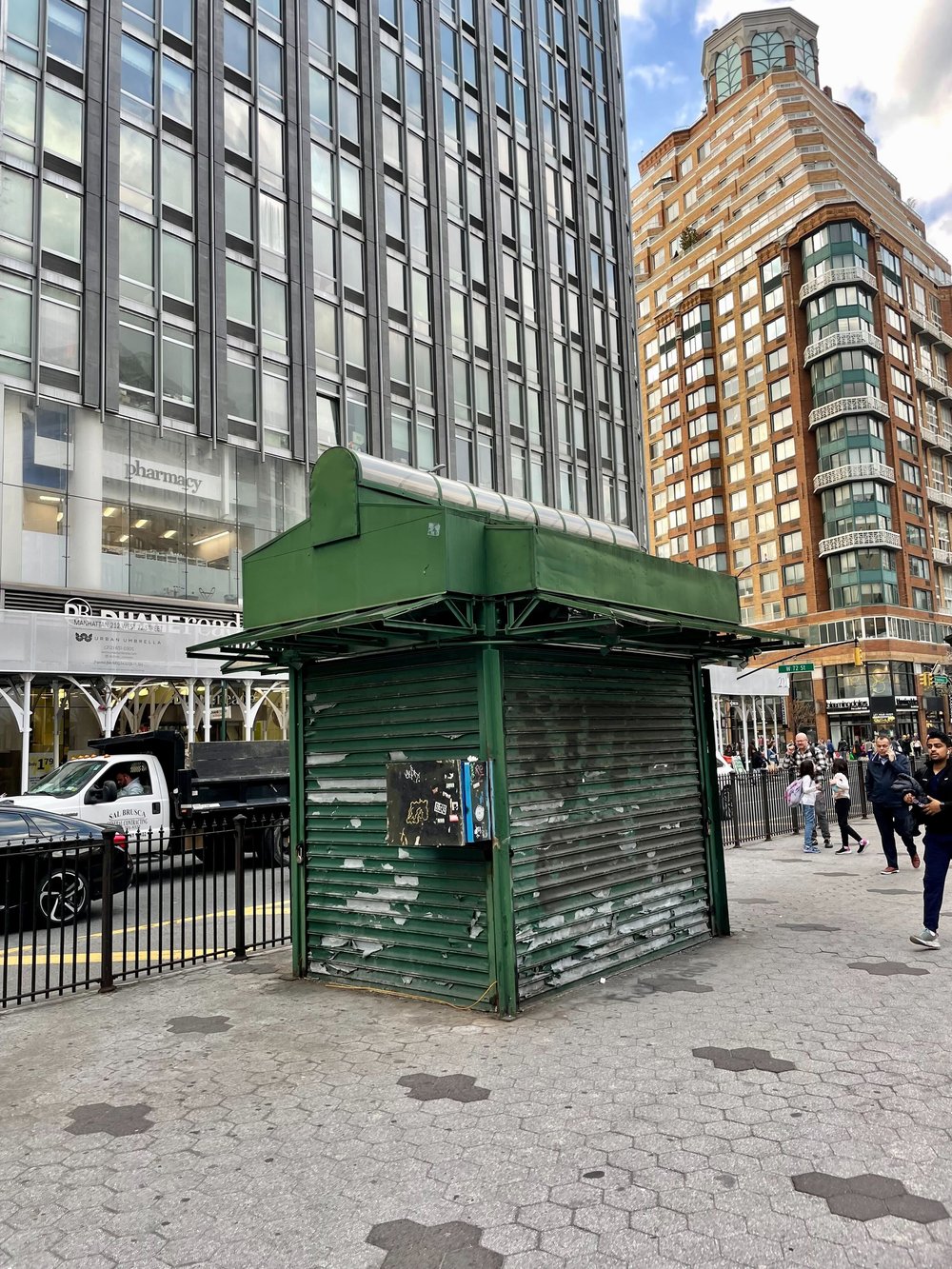‘The battle cry of the NIMBY': How unregulated tech is roiling the Upper West Side
April 10, 2023, 5:16 a.m.
Tech experts say a battle over the placement of an e-bike charging hub on the UWS is a harbinger of conflicts to come all over the country as apps and AI advance faster than laws.

One Upper West Side resident called it a “horrendously inappropriate location.”
Another warned that it was a "very, very dangerous thing to do."
Their concern is over the city’s proposal to convert a vacant newsstand into a rest space and e-bike charging station for delivery workers. The city wants to locate the hub at the southern end of the pedestrian plaza by West 72nd Street and Broadway, above a busy subway station. During a meeting last month, the local community board rejected the proposal, by a vote of 27-8.
The board’s vote is largely symbolic; it has no actual authority. But what, exactly, does it symbolize?
To some Upper West Siders, it was a classic NIMBY move: blocking a yearslong effort by the workers, who are mostly immigrant men, to improve their working conditions. To others, it's a reasonable defense against adding more traffic – and potentially explosive e-bike batteries – to a notoriously congested intersection.
And to some tech industry experts, this isn’t even a local news story: It’s a global issue disguised as a local one, and a sign of conflicts to come.
One by one, during the March meeting, residents spoke in courteous tones, many declaring the need for such a space in their neighborhood. Several people acknowledged the need to improve working conditions for the people who bring dinner to their doorsteps. A few said the proposed space wasn’t good enough for the workers.
But many commenters said they were against the proposed location.
When the public comments concluded, the board voted overwhelmingly against placing the hub at the proposed location.
The city has final say over the placement, thanks to a $1 million, federally funded pilot program to provide three rest stops across the city for 65,000 delivery workers. And while the board doesn’t have legal authority, it does act as a barometer for neighborhood sentiment.
Vivek Wadhwa, a robotics and artificial intelligence expert who has written about the ethics of social disruption in his book “The Driver in the Driverless Car: How Your Technology Choices Shape the Future,” said challenges like the one on the Upper West Side are “sparks of the fire that’s gonna get lit” within this decade as technology, like apps and AI, advances faster than guardrails can be established.
“There’s no playbook for this,” said Wadhwa, who has voiced worry about technology’s potential for social unrest as it alters communities and renders jobs obsolete.

'The battlecry of the NIMBY'
Katina Ellison has lived in the Upper West Side for decades and is the co-coordinator of the West 71st Street Block Association.
“I’m the opposite of a NIMBY,” she said. She emphasized that delivery workers “absolutely should have” a conveniently located rest stop within her neighborhood.
And yet her group, along with two other local block associations, sponsored a petition against the city’s plan for the hub and collected several hundred signatures.
In 2010, the intersection where Broadway and Amsterdam Avenue crisscross was referred to as the “bowtie of death” due to its shape and the high number of collisions that had occurred there. (In one two-year period, there were 34 crashes.) Around that time, Ellison was among the locals who advocated for safer conditions.
About 10 years ago, the DOT implemented improvements to traffic flow and safety — there have been zero fatalities and 34 collisions at that intersection in the past decade, 10 of them in the past two years, according to NYC Crash Mapper. It remains busy: The subway station is one of the most trafficked in the city, and it sits amid a vortex of bus routes, dotted with a tiny pedestrian island.
Ellison worried about cramming more e-bikes – which can whiz by silently when moving at speeds of 20 mph – into a narrow space that is already shared among elderly people, college students and parents with babies.
She suggested alternate locations: nearby unused buildings, a space in Central Park near Tavern on the Green. She also liked Chick-fil-A’s rest stop for delivery workers. But that was planned to be temporary, and is expected to close April 13.
Congestion issues aside, locals are worried that some bikers use uncertified batteries, which occasionally explode. E-bike batteries caused 220 fires in the city last year, up from 44 in 2020, according to data provided by the city.
While the bikes and their batteries can be risky, many delivery workers rely on them to earn a living, often charging them inside their apartments at night.
Last month, the City Council passed a slew of bills to curb the sale of lithium-ion e-batteries. NYCHA tried to ban folks from charging the bikes inside its buildings, but received so much pushback that it reversed course last fall. In March, the city and Con Edison announced a partnership to establish four outdoor charging stations at NYCHA complexes.
And yet, all those concerns – the central location and the need to charge e-bikes outside in safe conditions – are exactly why the hub made sense to Ken Coughlin, one of the few board members who supported placing it there.
“‘It's too congested’ is the battle cry of the NIMBY," said Coughlin. “It's much easier to mobilize people to defend the status quo than to advocate for bringing something new into the community.”
Ultimately, he said he’d like to see the delivery apps pay for the charging stations, but says “that isn't a good enough reason” to reject this proposal.
“They should be doing a lot better by their workers than they are,” he said. “Right now they're basically doing nothing except collecting money.”
Ligia Guallpa, head of the Worker’s Justice Project, which is among those spearheading the hub, said that despite the rejection, the meeting was a cause for optimism because so many residents supported the concept.
She said that the conversation could shift once she’s able to present more details and a design informed by the residents’ feedback.
“It's hard to have a conversation and a discussion when a design hasn't been presented yet,” said Guallpa.
Charging e-bikes outside is almost always safer than charging them inside, said K.M. Abraham, a research professor at Northeastern University's Center for Renewable Energy Technologies and an expert in lithium batteries. But he also recognized the apprehension around placing a charging station near an already crowded area. He said putting one in a park or in an empty building with proper fire safety precautions could be a reasonable option.
The elephant (not) in the room
So far, restaurants have stayed out of the fray. Andrew Rigie, the executive director of the NYC Hospitality Alliance, which advocates for the city’s restaurant industry, said that the conflict has “been between the deliveristas, governments and perhaps the third-party delivery companies that contract them as 1099s.”
“We strongly believe there is a shared responsibility,” said Guallpa, adding that she sees this issue as belonging to the community, city government, the workers and the apps.
Undergirding this tension are the delivery apps – GrubHub, DoorDash, UberEats – which are headquartered in other states. None of their representatives spoke at the community board meeting. UberEats has not responded to requests for comment.
A spokesperson for GrubHub, Liza Dee, said the company is “grateful to the city and the federal government” for supporting the worker hubs.
“We are ready to work with them in any way we can to make sure this initiative is implemented and expanded successfully,” she added.
Eli Scheinholtz, a spokesperson for DoorDash, said the company was not involved with this hub, but is “always trying to figure out ways to best support dashers.” He pointed to the company’s partnerships with Zoomo and Dirwin, which offer discounts for their delivery workers. He also pointed to a page on the company’s website with safety tips from the FDNY for devices using lithium batteries.
I want to be clear that I want a location ... I think we need more than one, and I don't want to overburden any particular area and I need ideas.
Councilmember Gale Brewer
Takeout existed in New York City long before these companies did. But the apps, along with the pandemic and its subsequent indoor dining closures – propelled food delivery to a $150 billion global industry — triple what it was in 2017— and New York City is one of the biggest markets.
While business has exploded, regulation has not. Expecting tech companies to step up and help provide worker protection is unrealistic, said Wadhwa, because they see their job as making the most money they can for their investors or shareholders.
Ultimately, he said the burden — and the hope — lands with lawmakers, but citizens have to spur them to the right action.
City Councilmember Gale Brewer, a longtime veteran of city government, is not taking the community board’s decision lightly. She said she’s been talking to local residents about where else the hub could go and she’s open to hearing from an architect and an engineer about the proposed location, but added, “It’s very small.”
Brewer also thinks the delivery app companies should be funding batteries and helping to find and fund charging stations. She, too, referenced the Chick-fil-A rest hub as a promising start.
“I want to be clear that I want a location,” said Brewer. “I think we need more than one, and I don't want to overburden any particular area and I need ideas.”
In a statement, a spokesperson for the parks department, Izzy Verdery, said the agency is “committed to hearing concerns and feedback from all stakeholders.”
For now, the design is in its early stages and the project doesn’t have a public timeline. The parks department said the hub is moving forward at that location. It is working with several city agencies – including the FDNY and the transportation department – along with private entities to incorporate the community's feedback, the department said.
Coughlin, one of the board members who supported the hub, maintains the installation would provide a net benefit.
“This is something that benefits everybody, ultimately,” he said. “Reducing injuries and deaths from apartment fires is a public good that we should all be getting.”
Clarification: After this story was published, the parks department clarified the current status of the hub. This story has been updated.
Upper West Side votes against proposed rest stop for delivery workers at 72nd Street